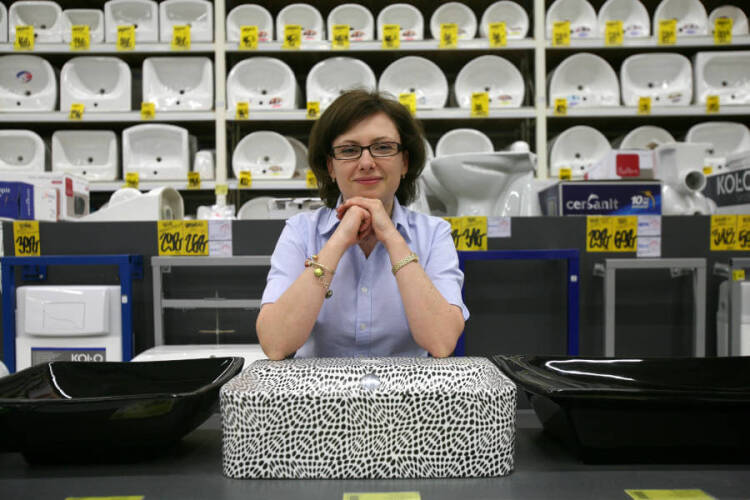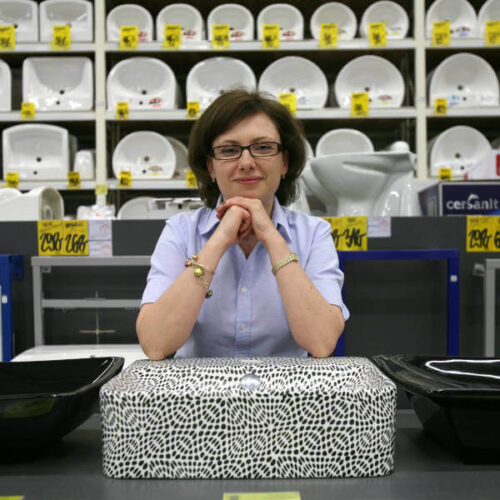In the second half of the 1990s, first stores of the French chain Castorama opened first in Warsaw and then in Poznań and Katowice. At the time, other chains of stores with DIY articles and home and garden products started their business in our country. The market was very receptive, however competition was strong.
Today, after over ten years of operation, Castorama Poland, operating under Castorama and Brico Depot brands, ranks first in the category of DIY (do it yourself) stores in our country. It is also a leader within the Kingfisher corporation (in 2002 the Kingfisher Group acquired 100% of the Castorama Group’s shares) in terms of the number of new stores, revenues and dynamic growth.
A good organisational culture, modern management standards and competence of employees are the key to success. The Management Board of the Group decided to use the potential of this thriving branch by planning the implementation of a system that supports broadly defined financial and controlling functions in Kingfisher. In early 2009, Castorama Poland was chosen as the company where the SAP system would be implemented. Since the beginning, the conceptual and implementation work aimed at working out a solution that would be universal enough to serve as a corporate template of the financial platform to be rolled out to other companies of the Kingfisher Group.
Choosing SAP as a solution for accounting and financial control in a globally operating corporation seems natural since the system ensures the consistency of business processes at the group level, and country-specific versions provided and updated by the system manufacturer guarantee operation in accordance with national finance and accounting law.
The implementation project and simultaneously the template building project in Castorama began in mid-2009. The system went live in May 2010. The SAP system covered finance and controlling, asset management and treasury areas. The system is used by the finance department staff. This is more than 200 people in over 60 locations (stores) all over Poland. It was also decided to implement SAP tools supporting project management (SAP PS) due to the company’s business needs related to investment accounting.
Castorama, like most retailers, uses also specific logistics systems (including POS, purchasing and sales systems) as well as banking and reporting systems. The project scope included also building interfaces to connect these solutions with SAP.
Local perspective, global perspective
The objectives of the implementation project were two fold -firstly, to streamline financial processes in Castorama Poland by using the SAP system, and secondly – in the long term – to improve business effectiveness in the Kingfisher Group through the use of best practices from Poland and standardisation and automation of key processes at the corporate level, irrespective of the location ofthe branch. Of course, the achievement of the latter objective will involve the successive rollout of the developed SAP template to further companies of the Group.
In the projects in which solutions intended to function in various companies and diversified business environment are created, it is important at the stage of building a concept to discuss the scope of requirements and needs of local companies that should be taken into account and to determine the limits of the benefits that the company can achieve through standardisation of processes at the expense of adaptation to local specificities. This is the more important in companies such as Kingfisher, where local branches have considerable autonomy of operation and – like Castorama Poland – generate the largest portion of the Group revenue.
The selected strategy usually results from the level of centralisation, the business profile of individual branches, as well as the level of maturity of the markets or organisational culture.
From the perspective of the interests of the Group, benefits from the unification of basic business processes are obvious. The introduction of the same structure of a chart of accounts in all branches standardises the record keeping. The creation of a standard reporting data format common to all branches means faster closing of accounting periods. The proper modelling of the chart of accounts and organisational structure in the finance and controlling area significantly simplifies and standardises monthly reporting at the management board level. Additionally, delivered SAP functionalities that support period closing shorten the time needed to prepare the data required by the Kingfisher Group.
Choosing Castorama Poland as the branch responsible for providing business know-how for creating a system template means to it -in addition to the satisfaction of being appreciated for its contribution to the development of the Group and confirmation of its strong role -an opportunity for the future to become a strong SAP competence center in the Group and to be able to initiate system extensions as its needs grow.
However, there is also the other side of the coin. The unification and standardisation involved making several compromises and recognising the priority of the interests of the Group over the interests of the company. One such compromise was the introduction of a uniform chart of accounts based on the logic defined by the Kingfisher Group, and the creation of the system architecture in accordance with the policy and procedures of the Group.
Financials in SAP
The most important feature in the finance management is a new general ledger that allows for parallel bookkeeping in separate ledgers. The company decided for parallel bookkeeping on the basis of four ledgers created for the purposes of group, local, consolidation and fiscal valuation. SAP offers numerous functionalities of the new ledger, which have been implemented by the company, including closing periods for each of the ledgers separately, posting of depreciation of fixed assets from separate valuation areas to relevant ledgers, valuation of balance sheet accounts according to separate methods for each of the ledgers.
The appropriate definition of groups of fixed assets enabled the proper categorisation of the property owned, and many additional features recorded in fixed asset registers facilitated asset data reporting.
For the purposes of monthly reporting to the Management Board, not only an appropriate chart of accounts but also all account assignment objects, such as business areas, profit centers, cost centers, consolidation operations, were created.
Identification of bank transactions
In addition to standard FI functions available in SAP, a tool that to large extent automates the identification of bank transactions and their registration, settlement and posting in the system was developed to meet the needs of Castorama.
More than 700 out of over 1,500 suppliers deliver commercial goods. Castorama collectively makes its payments to suppliers once or twice a week. The large scale of this activity is proven by the numbers: one such session can include up to 35 thousand invoices often totalling over PLN 100 million.
Currently, all transfer orders are generated from the SAP system. Then, each transaction carried out from the bank account of Castorama is recorded on a bank statement, which is eventually stored in the system. Due to the large number of stores, consolidations of balances from store accounts into the main account are carried out on a daily basis. Postings of funds between accounts are made to appropriate account assignment objects, depending on the origin of funds. Based on the bank statement data, these operations are posted to relevant accounts with an appropriate account assignment using special algorithms.
The biggest challenge in this process is the number of transactions and their diversity (cash payments, payments with credit and payment cards of various types, hire-purchase settlements, etc.) -and individual items on the bank statement should be assigned to a relevant counterparty and transaction. It is a difficult task since the bank statement contains too little information to enable it to be done automatically. For example, payments using various payment cards and hire-purchase are identified on the bank statement by the same code.
Controlling
In the controlling area, Castorama decided to build a structure that allowed data analysis at each level of the organisational structure. Thus, the data in reports can be aggregated by a type of activity, a type of brand (Castorama, Brico Depot), regions, locations of stores and departments. Such a detailed breakdown resulted in the creation of more than 2,600 controlling objects, i.e. profit centers and cost centers.
This structure can be used as a basis for the analysis of the performance of individual stores (business units). In this way, the effectiveness of controlling the operating costs is increased and the managerial decision-making process is improved. Furthermore, a uniform structure of cost types enables the data to be efficiently transferred to an external system and consolidated with data of other Kingfisher Group companies
We build new stores in SAP
During the project, it was also decided to implement project management tools (SAP Project System). The immediate reason for extending the scope was the need for detailed budgeting and capital expenditure planning.
Castorama opens several new stores per year and wants to maintain this momentum in the future. Any such investment involves the purchase of land, construction of a store building, purchase of equipment, organisation of infrastructure, etc. It is a huge number of documents to be registered for such investment and to be allocated to finished structures and fixed asset registers.
Currently, PS is used both to account for expenses related to newly opened stores as well as expenditures in existing stores. The first months of using the system were difficult, but now the company appreciates the possibility to use SAP PS as a tool for budget control and comparison with actually incurred expenditures.
Five parties to the project
The projects such as SAP system implementations in multinational corporations often entail additional organisational challenges. In addition to the scale of the project, it is necessary to take into account the differences in the business approach in individual branches, a different profile of business, and even such aspects as a different work culture and multiplicity of languages of communication. One of the biggest organisational challenges in the project at Castorama was the number of parties involved.
Firstly, the initiator of the project and the primary decision-making body was the parent company, i.e. Kingfisher. On its behalf, Kingfisher IT Services (KITS), a company spun off from the Group structures and dedicated to development and administration of IT infrastructure, was responsible for the technical part (mainly for SAP Basic). Castorama Poland was the main party to the project and a partner responsible for developing a business concept of the system and its operation in accordance with the expectations of the company.
Sopra Group, a a major European Consulting, Systems Integration company, was Kingfisher’s implementation partner responsible for the development of the solution concept for the corporation. And finally -the fifth participant in the project, that is BCC. Initially, an executive role was planned for SNP, a partner for both Sopra Group and Castorama, and it was entrusted with the responsibility for solution configuration and user training. However, due to the dominant role of the Polish company in the Group structures and the task of building a system template based on its experience, the role of the implementation partner from Poland turned out to be also significant.
With such a complex organisational structure, it is extremely important to assign roles and responsibilities at a high level of detail, to prepare a reasonable work schedule and of course to monitor the progress and achievement of partial objectives and planned milestones on the ongoing basis.
During the project, a lot of attention was paid to effective communication between the project participants. Every week, two weeks (depending on work intensity and a phase of the project) teleconferences attended by project managers and consultants responsible for selected works, as well as members of work teams on the customer’s side were held. The work progress was discussed, problems were solved and initial assumptions were adjusted on the ongoing basis. The main language of the project was English (in conceptual works, documentation and technical arrangements with KITS), however the Polish language was also used in communication between Castorama employees and SNP consultants.
The number of people involved in the project changed depending on the stage of the project. In the initial phase, when solutions were being defined and the project documentation prepared, strong commitment was required from key users -a group of 11 people, Castorama employees. However, in the implementation phase, when tests and training were being conducted, the project team on the side of Castorama grew threefold.
Initially, the decision to enlarge the team was not easy, considering the management of such a large team and additional costs, but ultimately it turned out that it was necessary. The project team was joined by accountants from regions, who acted as trainers and first line support for new users in the first weeks following the implementation.
Depending on the scope of work, three to six consultants from Sopra Group and SNP participated in the project. The technical side of the project was supported by ca. 10 people from KITS. An additional difficulty in the implementation of the project was a simultaneous project of Kingfisher to create a common chart of accounts, which required consultations with other companies in the Group.
A system ready for development
The SAP system successfully functions at Castorama and is a ready template of an effective financial platform for other companies of the Group and a powerful reporting tool for purposes of the Kingfisher Management Board. The developed template solution is also ready for further extensions and implementations of other logistics tools. This is proven by the ongoing project to implement materials management tools (SAP MM). SAP Retail will allow for the concentration of processes related to customer relationship management, sales and purchasing while ensuring effective cost control.
Further projects of the SAP system development at Castorama have been planned already.

Monika Pietryszak, Chief Accountant, Castorama Polska
Better effectiveness, automation of postings
We welcomed the decision to implement SAP FI/CO with great enthusiasm and commitment. We expected to eliminate weaknesses of the previous system in the new one, increasing the effectiveness and improving accounting processes. A positive value for us is the possibility to keep a separate ledger to record costs and tax proceeds, and a separate book for group reporting according to IAS, as well as the automation of postings, especially bank statements. Further dynamic growth of the company entails the need to add other SAP functionalities, and to connect the SAP system with external systems, including a document workflow.
Monika Pietryszak, Chief Accountant, Castorama Polska


